Summary of Findings
 With the war in Iraq over, Americans are feeling more optimistic about a turnaround in the national economy, and a greater number than at the beginning of the year think that President Bush is doing as much as he can to improve economic conditions. But the president’s tax cut proposal continues to be a non-starter for the public. Just a quarter of Americans say they have been following news about the president’s tax cut plan very closely, and just 40% approve of it.
With the war in Iraq over, Americans are feeling more optimistic about a turnaround in the national economy, and a greater number than at the beginning of the year think that President Bush is doing as much as he can to improve economic conditions. But the president’s tax cut proposal continues to be a non-starter for the public. Just a quarter of Americans say they have been following news about the president’s tax cut plan very closely, and just 40% approve of it.
These are the findings of the latest nationwide Pew Research Center survey of 1,201 Americans, conducted April 30-May 4, which shows the percentage of Americans expecting the economy to be better off next year rising to 43% from as low as 30% in January and 33% about a month ago.
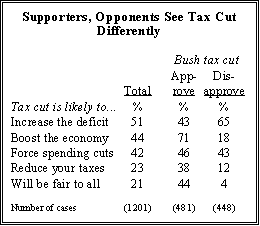 But the public is less upbeat about Bush’s tax plan. A solid majority (56%) say the tax cuts will mainly benefit wealthy people, compared with just 21% who believe it will be fair to everyone. Asked about the possible impact of the tax cut, most Americans (51%) believe it will increase the federal budget deficit. About four-in-ten believe the tax cut will boost the economy and create jobs (44%), and roughly the same number expect it will force the government to reduce domestic spending (42%). Fewer than a quarter (23%) expect the plan will significantly reduce the taxes they pay. Viewing the proposal as an economic stimulus is by far the most important factor in public support for the tax cut.
But the public is less upbeat about Bush’s tax plan. A solid majority (56%) say the tax cuts will mainly benefit wealthy people, compared with just 21% who believe it will be fair to everyone. Asked about the possible impact of the tax cut, most Americans (51%) believe it will increase the federal budget deficit. About four-in-ten believe the tax cut will boost the economy and create jobs (44%), and roughly the same number expect it will force the government to reduce domestic spending (42%). Fewer than a quarter (23%) expect the plan will significantly reduce the taxes they pay. Viewing the proposal as an economic stimulus is by far the most important factor in public support for the tax cut.
While the public has become more optimistic about the national economy, there is considerable awareness of the budget crisis facing many state governments. Public interest in news about state budgetary problems tends to be limited, but fully half of the survey respondents said they believed that government spending on social programs in their state had been cut this year. In states with especially severe budget shortfalls, as many as 64% have taken note of smaller state budgets for health, education and other social programs.
 George W. Bush’s approval rating stands at 65%, which is somewhat below his 72% rating in mid-April, as the war in Iraq was winding down. The president’s personal image is very strong: Asked for one-word descriptions of George Bush, people’s responses are overwhelmingly positive many describe him as “honest” or “good,” while others cite his leadership and confidence. “Arrogant” is the top negative associated with Bush. Personal evaluations of this president are more uniformly positive than was the case for Bill Clinton, who got mixed personal evaluations even as he was getting high marks for his job performance. By roughly two-to-one (52% to 27%) people use clearly positive words in their descriptions of the president, with 9% using somewhat neutral language.
George W. Bush’s approval rating stands at 65%, which is somewhat below his 72% rating in mid-April, as the war in Iraq was winding down. The president’s personal image is very strong: Asked for one-word descriptions of George Bush, people’s responses are overwhelmingly positive many describe him as “honest” or “good,” while others cite his leadership and confidence. “Arrogant” is the top negative associated with Bush. Personal evaluations of this president are more uniformly positive than was the case for Bill Clinton, who got mixed personal evaluations even as he was getting high marks for his job performance. By roughly two-to-one (52% to 27%) people use clearly positive words in their descriptions of the president, with 9% using somewhat neutral language.
Iraq continues as the top news interest story of the month, but attention in reports on SARS epidemic also has been substantial. About four-in-ten (39%) say they have been following stories on the mysterious respiratory virus very closely, which is slightly more than followed stories last year on the West Nile Virus (34%). However, personal concern over SARS has not grown in the past week. About four-in-ten (37%) say they are least somewhat worried about contracting the disease, which is unchanged from a Gallup survey in late April.
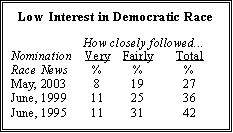 About three-in-ten Americans (31%) are paying very close attention to the Laci Peterson murder case. But even more people (39%) say the media is providing too much coverage of the story; just 11% think the media is under covering the case. Among recent high-profile crime stories polled, the O.J. Simpson murder case in 1994 attracted the highest interest (48% followed very closely). As the first major Democratic debate was taking place in South Carolina, interest in news about the race for the nomination was low just 27% were either very (8%) or fairly interested. This is considerably below levels of interest in the nomination races at comparable points in the 1996 and 2000 election cycles. Fully 41% say they have paid no attention at all to the Democratic race, up from 34% four years ago and 26% in 1995.
About three-in-ten Americans (31%) are paying very close attention to the Laci Peterson murder case. But even more people (39%) say the media is providing too much coverage of the story; just 11% think the media is under covering the case. Among recent high-profile crime stories polled, the O.J. Simpson murder case in 1994 attracted the highest interest (48% followed very closely). As the first major Democratic debate was taking place in South Carolina, interest in news about the race for the nomination was low just 27% were either very (8%) or fairly interested. This is considerably below levels of interest in the nomination races at comparable points in the 1996 and 2000 election cycles. Fully 41% say they have paid no attention at all to the Democratic race, up from 34% four years ago and 26% in 1995.
 Divided Over Economy’s Future
Divided Over Economy’s Future
The public is increasingly divided along political and demographic lines in its expectations for the nation’s economy. More than half of those (53%) in households earning more than $50,000 annually expect an economic turnaround in the next year, which is a significant surge in optimism from late-March/early-April. But the outlook in households earning under $50,000 annually has changed little over this same time span (37% optimistic, up from 32%).
Similarly, there is an 18-point gap in economic expectations between college graduates (53% optimistic), and those with no more than a high school diploma (35%). There was only a seven-point difference between these same groups a month ago (38% to 31%).
The partisan gap in economic expectations, which has persisted throughout Bush’s presidency, also has grown dramatically. Fully 63% of Republicans believe the economy will improve over the next year, up from 49% last month. Democratic views of the economy have not changed significantly and are much more negative. Just a quarter of Democrats expect economic improvement over the next year, little changed from a month ago (23%). More Democrats (31%) say things will get worse over the next 12 months, and 41% expect no significant changes.
Economic Expectations and Opinion of Tax Cut
These economic divisions have political ramifications for the president’s political image, as well as for his proposed tax plan. While economic optimism has risen, perceptions of the president’s efforts on the economic front are unchanged from a month ago 42% say he is doing as much as he can to improve the economy, while 53% believe he could do more.
Americans are also divided over the president’s tax proposal 40% approve, 37% disapprove, while 23% offered no opinion. In addition to being heavily influenced by partisanship, public views on the tax cut are highly related to economic evaluations. Those who expect the economy to improve favor the president’s proposal by three-to-one (60% approve/20% disapprove), but those who expect things to get worse oppose it by an even larger margin (14% approve/67% disapprove). And people who think the economy will remain largely unchanged are also unconvinced of the need for the tax cut (29% approve/44% disapprove). To some extent, this pattern reflects partisan differences in economic outlook, but the gap is nearly as large even when party affiliation is accounted for.
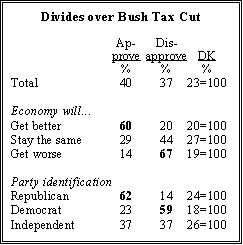 The public’s doubts about the president’s tax proposal are linked to perceptions of its consequences. Fully 85% of those who are against the tax cut say it will mainly benefit the wealthy, while just 32% of proponents agree. Conversely, 71% of the plan’s supporters believe it will boost the economy and create jobs, compared with just 18% of opponents who see this happening.
The public’s doubts about the president’s tax proposal are linked to perceptions of its consequences. Fully 85% of those who are against the tax cut say it will mainly benefit the wealthy, while just 32% of proponents agree. Conversely, 71% of the plan’s supporters believe it will boost the economy and create jobs, compared with just 18% of opponents who see this happening.
There are smaller, but significant, differences over other aspects of the proposal. Though supporters are more likely than opponents to say their taxes will go down (38% to 12%), a majority on both sides expects no personal benefit. A solid majority of tax-cut critics (65%) say it will increase the budget deficit, but more than four-in-ten of the plan’s proponents (43%) believe this is likely. And interestingly, roughly the same proportion of tax cut supporters (46%) and opponents (43%) believe the legislation will force the government to reduce domestic spending. Presumably, many of the bill’s supporters believe this is a good thing, while opponents probably see this as a
problem.
A significant minority of Americans (23%) declined to offer an opinion of the president’s tax plan. Fully eight-in-ten in this group say they have heard little (37%) or nothing (43%) about the kinds of taxes the president has proposed cutting. These Americans are skeptical that the tax cut will be fair (51% say it will benefit the wealthy, just 9% say it will be fair), and very few (15%) think they personally will benefit substantially from a tax cut. But these undecideds have not made up their minds about whether a tax cut is likely to boost the economy (40% say yes, 42% say no), or increase the federal budget deficit (41% say yes, 31% say no).
State Budget Crises: Awareness, Little Impact
The impact of the current economic slump on state budgets has become apparent to much of the American public particularly in states facing the most severe economic problems. But so far, the state budget crisis is not having much of an impact on the national political agenda.
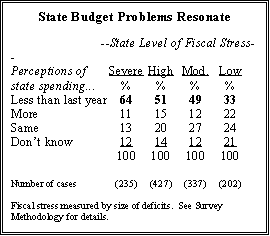 Overall, 26% of Americans say they are following news about state budget problems very closely, and another 34% are following fairly closely the public’s interest in this story is roughly comparable to its interest in the president’s tax cut plan and North Korea’s nuclear weapons program, though it ranks well below Iraq and SARS on the public’s news agenda.
Overall, 26% of Americans say they are following news about state budget problems very closely, and another 34% are following fairly closely the public’s interest in this story is roughly comparable to its interest in the president’s tax cut plan and North Korea’s nuclear weapons program, though it ranks well below Iraq and SARS on the public’s news agenda.
People living in states with the most severe budget problems, such as California and New York, are following the story more closely, and recognize the impact of the budget problems on health, education and other social programs. Fully two-thirds of residents of states facing the most extreme budgetary shortfalls say that spending on programs is being cut. This is far higher than in states facing much more modest economic problems, such as Florida and Arkansas.
But there is no evidence that these state fiscal problems are having an impact on the way people view national politics. Americans express the same levels of economic optimism in all states, regardless of the severity of the state’s budgetary problems, and support for the president’s tax cut proposal also appears unrelated to perceptions of state financial difficulties.
More Say Bush Influenced By Conservatives
 The president’s job approval remains very strong following the war in Iraq, with 65% approving of his performance in office, and 27% disapproving. This reflects a notable spike in the president’s approval rating from mid-March, prior to the start of the war (55%). But unlike the president’s handling of the terrorist attacks of Sept. 11, 2001, which brought him near universal approval from Republicans, Democrats and independents, the war in Iraq has not narrowed the partisan gap on the president’s performance. Currently, as many Democrats disapprove the president’s job performance (45%) as approve (46%).
The president’s job approval remains very strong following the war in Iraq, with 65% approving of his performance in office, and 27% disapproving. This reflects a notable spike in the president’s approval rating from mid-March, prior to the start of the war (55%). But unlike the president’s handling of the terrorist attacks of Sept. 11, 2001, which brought him near universal approval from Republicans, Democrats and independents, the war in Iraq has not narrowed the partisan gap on the president’s performance. Currently, as many Democrats disapprove the president’s job performance (45%) as approve (46%).
There also is a growing perception, among both liberals and conservatives, that the president is more closely tied with conservative wing of the Republican Party, rather than the party’s moderate faction. Just under half of all respondents (49%) say Bush listens more to conservative members of his party, up from 41% in January of this year, and 38% in January 2002. The percentage saying Bush listens more to conservatives is now as high as in January 2001, shortly after the president took office. Only about a third of Americans (32%) say Bush listens more to moderate Republicans.
Most conservative Republicans (54%) believe Bush listens more to conservative voices, while half of moderate members of the party see the president as being influenced more by moderates. Liberal Democrats are the most likely to think the president listens primarily to conservatives within his party, with fully two-thirds (66%) holding this view.
Iraq Improves Bush’s Image
There is little doubt, however, that the war in Iraq has improved the president’s image. By three-to-one (65%-22%), the public says the war in Iraq has helped, not hurt, the war on terrorism, and among those who think it helped, the president receives a resounding 81% approval rating.
Moreover, the one-word descriptions the public uses to describe the president reflect his role as commander-in-chief. In addition to being described as “honest” and a “leader,” terms that many used to describe Bush during the 2000 presidential campaign, some of the most common positive terms Americans use to describe him are “confident,” “courageous,” “determined,” “patriotic,” and “decisive.” Among the president’s detractors, “arrogant,” “cowboy,” and “idiot” are the most common descriptions provided.
The president’s current job approval rating of 65% is ten-points higher than in mid-March, before the start of military action in Iraq. Within the past month, it reached a peak of 74% in polling the day U.S. troops successfully captured Baghdad.

Iraq Tops News Interest Index
Once again, the situation in Iraq leads the monthly news interest index, with 63% of the public following this story very closely. Republicans are more likely to pay very close attention to this story (71% very closely) than Democrats or independents (62%, 60% respectively). A majority of respondents (55%) believes news organizations have been giving this story the right amount of coverage, while a third (34%) think there has been too much coverage.
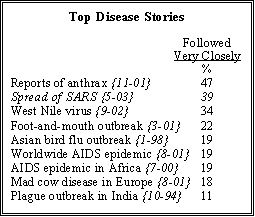 SARS is the second most closely followed news story this month, with 39% paying very close attention, and an another 39% watching it fairly closely. The SARS story receives uniform attention throughout the country, though women are following it slightly more closely than are men (43% very closely vs. 36%).
SARS is the second most closely followed news story this month, with 39% paying very close attention, and an another 39% watching it fairly closely. The SARS story receives uniform attention throughout the country, though women are following it slightly more closely than are men (43% very closely vs. 36%).
Public interest in SARS is similar to last year’s coverage of the West Nile virus last summer (34% followed very closely). Among health-related issues, only the November 2001 Anthrax scare, with its links to the broader issue of terrorism, received significantly higher public attention (47% followed very closely).
Overall, six-in-ten Americans (59%) feel news organizations are giving SARS the right amount of coverage, and there is no sign that the public is feeling saturated by SARS coverage. Just 18% say there has been too much coverage of the disease; the same percentage says there has been too little coverage.
Three-in-ten Americans (31%) are closely following the murder of Laci Peterson, the pregnant California woman whose husband has been charged in her death. Women are tracking this story significantly more than men (40% vs. 22%).
Non-whites are following the Peterson story much more closely than whites (42% vs. 28%). In addition, whites are more likely than minorities to say that news organizations are giving too much coverage to this story (42% vs. 28%). Overall, 39% of Americans say Laci Peterson’s murder has received too much coverage, while 39% feel there has been an adequate amount of coverage and just 11% say there has been too little news attention.
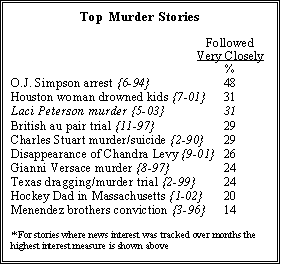 Public interest in this story is on par with attention to the case of the Houston mother who drowned her children in a bathtub in 2001, the 1997 murder trial of a British au pair, and the 1990 incident involving Charles Stuart, who murdered his pregnant wife in Boston and blamed it on an African-American. However, the O. J. Simpson arrest in 1994 remains the most closely-watched crime story of recent years (48% very closely).
Public interest in this story is on par with attention to the case of the Houston mother who drowned her children in a bathtub in 2001, the 1997 murder trial of a British au pair, and the 1990 incident involving Charles Stuart, who murdered his pregnant wife in Boston and blamed it on an African-American. However, the O. J. Simpson arrest in 1994 remains the most closely-watched crime story of recent years (48% very closely).
Attention to news about North Korea’s nuclear weapons program has declined somewhat since March; a third of the public followed this story very closely then (34%), compared with 27% in the current survey.
Interest in the president’s tax plan has not changed significantly since early this year (25% very closely now, compared with 28% in January). Married people have followed Bush’s economic plan more closely than have unmarried Americans (30% vs. 19%).
Only about one-in-ten Americans (12%) are paying very close attention, and 24% are paying fairly close attention to recent debates about affirmative action programs. Non-whites are much more likely to be interested in this news story than are whites (21% following very closely vs. 10%). African-Americans and Hispanics are about as likely to track this story very closely (24% and 20%, respectively). Interest in reports on affirmative action is lower than in the summer of 1995, when 20% followed such stories very closely, and 32% somewhat closely.
Only 8% of Americans are following the race for the Democratic presidential nomination very closely. Not surprisingly, Democrats are more interested in the contest for the nomination than are Republicans (11% vs. 4%). But independents are as interested as Democrats, with 10% of independents following very closely. There is no evidence that residents of states with early primaries or caucuses such as Iowa, New Hampshire, South Carolina or Michigan are paying any closer attention to the race for the nomination than are people in the rest of the country.


